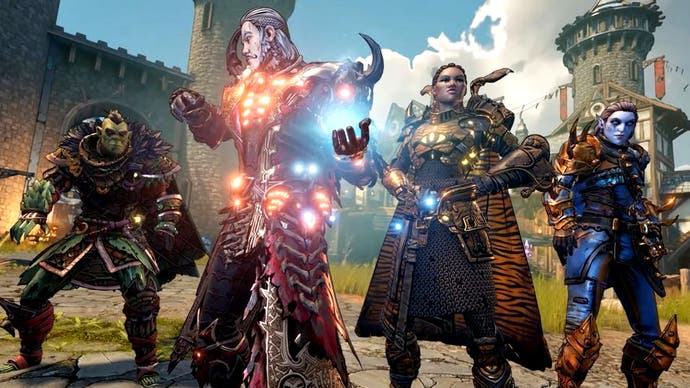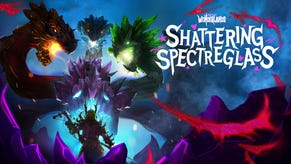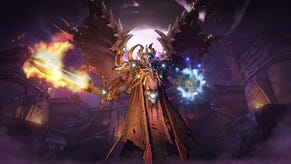Tiny Tina's Wonderlands: a Borderlands tech rehash - or something new?
PlayStation 5 and Xbox Series consoles tested
Who saw this coming? As a self-contained spin-off to the Borderlands series, Tiny Tina's Wonderlands takes one of the more charming characters from its universe and invites us on a dungeons and dragons-style detour. The idea is undeniably cute. Think of Borderlands' FPS mechanics as seen through the lens of a table-top Dungeons and Dragons campaign, and you're on the righty track. But at its core, we’re still looking at an extension of the same Unreal Engine technology that’s at the foundation of Borderlands 3.
In terms of its tech, Tiny Tina's Wonderlands has a few extra twists. Unlike the open-world roaming in mainline Borderlands, here we navigate between key areas using a table-top style world map. It's oddly akin to an old-school JRPG world maps as you guide a super-deformed version of your character between missions. A few tricks in the Unreal engine suite help sell the idea, too: a heavy depth of field creates a lovely tilt shift photography effect - another reminder that you're a tiny figurine on a table-top. You'll see bottle caps and pins dotted around, and all round it's a pleasant departure from the typical open-world Borderlands approach. No need for vehicles here, either. As a result, missions are also more focused in design. More linear, too; once you enter an area, you have some lateral movement within a map to explore - but these are often more contained experiences, like themed fairground rides.
PS5 and Series X offer two graphics modes: a 4K, 60 frames per second resolution mode (with a dynamic 1800p to 2160p window) alongside a lower resolution performance mode - which unlocks 120fps support on these consoles with the appropriate display attached. Series S has just the one mode targeting 60fps, scaling all the way from 960p to 1440p – meaning a significant reduction in clarity. Graphics features are evenly matched between the higher end machines, though for Series S, grass density and shadow quality are pared back by comparison. On the face of it, there’s the sense that Series S is overly cut back once again, but viewed in isolation, the experience still pays off – and performance trumps higher-end settings in a title like this one.
In comparing the resolution modes on PS5 and Seriex X, frame-rates are generally acceptable using 60fps as a target. On each console you'll spot occasional, jarring lurches into the high 50s - just as alpha effects fill the screen or even while turning the camera rapidly. It’s hardly the worst-case scenario, but these drops do stick out in the heat of the action. This goes for PS5 and Series X in equal measure. Perhaps predictably, Series S is essentially less stable overall in its performance profile. Frame-rates are acceptable overall, but drops into the 50-60fps range are more common and long-lasting than the premium consoles.
Shifting the focus to the Series X/PS5-exclusive performance mode, there’s an interesting wrinkle here in that this option actually offers two different experiences, depending on your connected display. The target resolutions drops to a locked 1080p, which enables an essentially consistent 60fps on a 60Hz screen. Consider this is a ‘nuclear’ option in ensuring a silky smooth, consistent experience all day long. It’s actually very useful for the split-screen option, which is traditionally more taxing for both CPU and GPU, and so lowering resolution to 1080p gives PS5 and Seriex X the overhead to deliver consistency at 60fps.
The nature of the performance mode changes if the console is hooked up to a 120Hz screen. As long as 120Hz is also selected on the console's front-end, the frame-rate becomes unlocked using the performance mode on PS5 and Series X. In practise though? Expect a 80-120fps range in general on PlayStation 5 and a slightly higher 90-120fps range on Xbox Series X. This kind of output still shows noticeable judder, but this is where variable refresh rate (VRR) support makes a big difference. That is in single-player mode though – and yes, factoring in split-screen, the performance window opens up significantly depending on the intensity of a shootout.
A final word on loading times: Series X may have an advantage at 120Hz due to its higher overall frame-rates and VRR support, but much like Borderlands 3, PS5 has leads in loading speeds. Going from the table-top map to the Queen's Gate area takes PS5 eight seconds to load, up against the circa 11 seconds on both Xbox consoles. All three deliver relatively short loading speeds overall, though once again PS5 just edges out the Xbox consoles.
Ultimately, Tiny Tina's Wonderlands is a surprising twist on the Borderlands concept. Gearbox takes its chance to inject humour into a new fantasy setting, the world map is a charming, and the Dungeons and Dragons-style upgrades separate it from Borderlands' usual approach – but let’s be clear, this is still a Borderlands game at its heart. That extends to its tech credentials and performance profile too even at 120fps. The lack of options for Series S remains a bit of a sore point and I wish we'd seen another option to salvage performance, even if it did mean lowering the resolution, or more visual settings. As for Series X vs PlayStation 5? Both version come highly recommended – just make sure to tap into the performance mode to get the best out of split-screen play.











